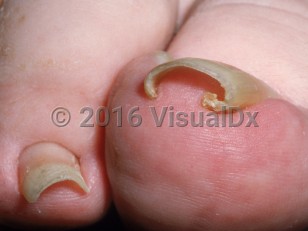Pincer nail deformity - Nail and Distal Digit
Alerts and Notices
Important News & Links
Synopsis

The condition is more common in women and typically presents in the fifth decade. It occurs frequently on the toes, particularly the great toenails, and only rarely on the fingers. Pain is a common complaint and can be intense. In time, the lateral nail plate edges dig into the lateral grooves and progressively pinch the nail bed. Ultimately, the lateral borders of the nail plate join together leading to the so-called trumpet nail.
Pincer nail may be inherited or acquired. Acquired cases may be caused by osteoarthritis, ill-fitting shoes, subungual tumors, psoriasis, onychomycosis, arteriovenous fistula of the forearm, Kawasaki disease, beta blockers, and paraneoplastic sign. Poorly fitting shoes is the most commonly cited cause. Inherited pincer nail is rare, but an association has been reported with Clouston syndrome. In the hereditary cases, the pincer nail is typically bilateral and involves the fingernails.
Codes
L60.8 – Other nail disorders
SNOMEDCT:
247486000 – Pincer nail deformity
Look For
Subscription Required
Diagnostic Pearls
Subscription Required
Differential Diagnosis & Pitfalls

Subscription Required
Best Tests
Subscription Required
Management Pearls
Subscription Required
Therapy
Subscription Required
Drug Reaction Data
Subscription Required
References
Subscription Required
Last Updated:07/01/2019

